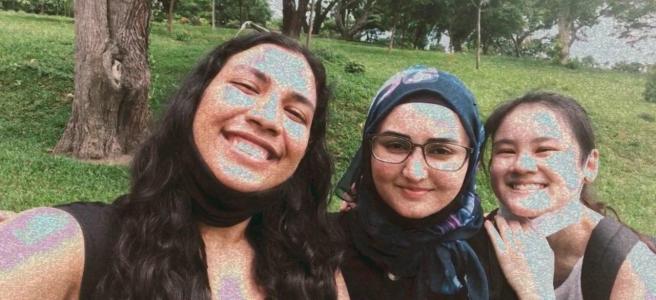The objective of the hike was to spot a troop of long-tailed macaques and observe how they behave in their troop. I prepared a booklet for my friends that contained information about the different types of monkey that reside in Singapore.

We trekked for about an hour before we spotted a troop of long-tailed macaques. I counted about seventeen macaques in total. We saw a baby macaque on clinging on its mother! We were also able to differentiate the juvenile macaques from th adult macaques due to the vast difference in their sizes There are some monkeys on the ground, looking for food in the grass while there are other monkey who were hanging on the tree branches.
When we were observing the monkey (we made sure to keep a safe distance and to not stare for a prolonged period), my friend noticed that one of the macaque was staring at us so we quickly move away. I took this opportunity to explain to my friends that long-tailed macaques associate themselves in social groups, and there is a hierarchy (make and female) within each of this social groups. The alpha male of the troop is the one that protects its troop from external threat, and therefore, I hypothesised that the monkey that stared at us might have been the alpha male of the troop and might have perceived us as a threat as we might have accidentally exhibited behaviour that might be deemed aggressive to the macaque.



All photos are taken by my friend, Sharmeen Wasim!
We witnessed a human-macaque conflict in action while we were observing the troops. A couple was walking their dog, who was on a lease, and the dog walked towards the troop. One of the macaques approached the dog aggressively, which caused the dog to bark. The couple pulled the dog towards them and carried it before the conflict escalated. My friends and I thought that this incident could have been easily prevented if the couple was more considerate and carried the dog before walking by the troop. It prompted me to think of how human-macaque conflicts can be easily reduced or eliminated as a whole if we could be more considerate and take responsibility.
Though our main aim was to observe long-tailed macaques, we witness other wildlife as well. We saw a monitor lizard hunting for food and watched it while it feed on it’s food. I am not too sure what kind of lizard it was, but it seems like it is a Malayan water monitor to me. Please do correct me if I am wrong, thank you!
I have some takeaway points to wrap this experience up. I believe that the best way to make biodiversity in Singapore matter to us is to initiate conversations. By organising this hike, I was not only able to educate my friends, but I was also able to spread the knowledge to their parents as they showed the booklet I conceptualised to her family members. Additionally, I also realised that there is a plethora of information online which has not reached to the general public in Singapore. I am not too sure if there has been previous large-scaled campaigns that have been organised to educate the general public, but I believe that organising one will help to initiate conversations within the community.
Going forward, I want to continue stirring conversations about biodiversity in Singapore. To do so, I have created an Instagram handle on which I plan to post content about the biodiversity in Singapore. In addition, I will also be documenting my personal journey in improving my understanding of the local biodiversity on this Instagram page!
